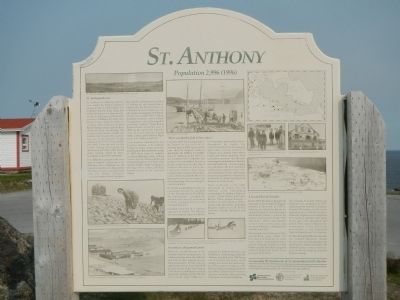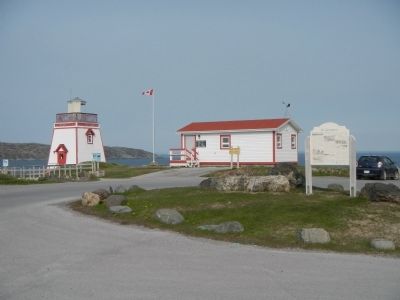St. Anthony in Great Northern Peninsula, Newfoundland, Newfoundland and Labrador — The Atlantic Provinces (North America)
St. Anthony
Population 2,996 (1996)

Photographed By Barry Swackhamer, June 28, 2014
1. St. Anthony Marker
Captions: (clockwise from the upper left) St. Anthony as viewed from Fox Farm Hill, circa 1930.; The Mission wharf, 1909.; (map of St. Anthony); Children at the Mission school on a skiing expedition.; The first St. Anthony hospital, 1901.; The Canada -U.S.A. Aircraft Control and Warning System, 1950s.; Winter healthcare services were provided by dog teams ans when required airplanes equipped with skis (note the Strathcona I in the background.; A.H. Murray fishplant and premises on the east side of St. Anthony.; Women spreading salt codfish to dry on the rocks.
St. Anthony Haven
By tradition St. Anthony harbour was named by French explorer Jacque Cartier in 1534. Indeed, it is probable that the long, deep and sheltered harbour was already well-known to fishermen of the French province of Brittany for some time before Cartier made his historic voyages. The harbour provided Breton fishing vessels with the best sheltered base for fishing the grounds of the Straits of Belle Isle and the Grey Islands. This harbour was one of the primary French stations on the Petit Nord up until the mid-1800s. From this time on, the French fishing effort gradually decreased until 1904, when French shore fishing rights in Newfoundland waters were abolished.
It is difficult to pinpoint the exact date of English settlement at St. Anthony, since settlement by the English was technically illegal under the terms of treaty arrangements with the French. However, Newfoundlanders from Conception Bay and the northeast coast persisted in fishing off the French Shore. Meanwhile, the French (who were forbidden to over-winter) saw the advantage in engaging Newfoundlanders to oversee their fishing premises as gardiens, and it is these few guardians who can be regarded as the first “settlers.” When Bishop Edward Field visited the area in 1849, on his way to the Labrador coast, he noted only one English settler, J. Macey, at St. Anthony Bight, north of St. Anthony harbour.
Local tradition identifies the two founding families at St. Anthony harbour as Patey, on the west side, and Simms on the east. By the census of 1857 there were 11 families recorded (although some of these were living at St. Anthony Bight) and a total population of 71. Soon other families settled, either to engage in the local shore fishery, the Grey Islands fishery or the Labrador fishery.
”We’re wonderful glad to have you”
Unquestionably the turning-point in the history of the town of St. Anthony came in 1899. It was in that year that an English medical missionary, Dr. Wilfred T. Grenfell, chose St. Anthony as the site for a new hospital to serve Labrador and northern Newfoundland. It was to be the winter base for the Royal National Mission to Deep Sea Fishermen, under whose aegis Grenfell did his medical missionary work, which was aided by the use of dog teams over land in the winter and the medical ship Strathcona along the coast in summer.
By 1912 Dr. Grenfell felt his work was expanding beyond the mandate of the British-based RNMDSF. He subsequently founded the International Grenfell Association (or IGA), popularly known as the “Grenfell Mission.”
Grenfell believed in a holistic approach to health. The Mission developed many projects in addition to its hospitals and nursing stations throughout the region: the improvement of diet by encouraging agriculture and the keeping of livestock. In a country where many health and dietary problems were caused by poverty, the Mission encouraged communities to become more self-sufficient - by developing new industries. The IGA operated a lumber mill, co-operative stores, orphanages and encouraged the development of handicrafts as a form of occupational therapy and cash income.
There continued to be some movement of people into St. Anthony from surrounding communities. St. Anthony Bight, St. Carol’s, Great Brehat and Little Brehat. These people brought a number of now-familiar family names into the town, including Budgell, Colbourne, Cull, Elliott, Kinsella, Pilgrim, Richards and Simms.
Growth as a Regional Centre
With the establishment of the Grenfell Mission headquarters, St. Anthony became more self-sufficient and it led to other regional services being located here. In 1928 a slipway and marine railway was built which proved a boon to the local fishery. A.H. Murray established a salt fish plant at St. Anthony in 1935. The War years of the early 1940s saw a demand for fresh-frozen fish, with Job Brothers’ cold storage plant in St. Anthony (established in 1944) being one of the first fish plants in the country to have this new technology. In 1957 the plant as taken over by Fishery Products Limited, and in the late 1990s Chianti Food Processors operated secondary fish processing from newly renovated buildings.
A Second Era of Growth
By the 1950s the fishery, though still important, was no longer the biggest industry in town. In 1950 St. Anthony was selected as the site of the joint Canada-U.S. Aircraft Control and Warning System - part of the defence system known as the “Pine Tree Line”. Many local people worked in the construction and servicing of the base, which operated until the late 1960s.
More people moved into town from surrounding areas under the Resettlement Program. In some cases, whole communities were moved. Primarily families in Little Brehat, and the Hare Bay villages of Ireland’s Bight and Lock’s Cove moved to St. Anthony.
The Charles S. Curtis Memorial Hospital was completed in 1967, replacing the 40-year old St. Anthony Hospital. The harbour facilities were upgraded, and in 1968 the Northern Peninsula Highway was completed to St. Anthony and later other roads in the area were upgraded and paved. These actions indicated the commitment of the provincial government to the continued regional importance of St. Anthony.
In 1981 the Grenfell Mission became the Grenfell Regional Health Services, and was incorporated into the Province’s healthcare system. Dr. Grenfell’s home in now a museum, part of the developing regional tourism strategy.
Erected by Community Historyboards of Newfoundland and Labrador.
Topics. This historical marker is listed in this topic list: Settlements & Settlers. A significant historical year for this entry is 1534.
Location. 51° 21.357′ N, 55° 33.352′ W. Marker is in St. Anthony, Newfoundland and Labrador, in Great Northern Peninsula, Newfoundland. Marker is on West Street, in the median. Touch for map. Marker is in this post office area: St Anthony NL A0K 4S0, Canada. Touch for directions.
Other nearby markers. At least 2 other markers are within 3 kilometers of this marker, measured as the crow flies. Fox Point Lightouse (within shouting distance of this marker); Sir Wilfred Thomason Grenfell (approx. 2.2 kilometers away).
More about this marker. This marker is located in the center of the traffic loop at the eastern end of West Street.
Also see . . . St. Anthony, Newfoundland and Labrador - Wikipedia. St. Anthony is a town on the northern reaches of the Great Northern Peninsula of the Canadian province of Newfoundland and Labrador. (Submitted on December 15, 2014, by Barry Swackhamer of Brentwood, California.)
Credits. This page was last revised on February 9, 2022. It was originally submitted on December 15, 2014, by Barry Swackhamer of Brentwood, California. This page has been viewed 735 times since then and 43 times this year. Photos: 1, 2. submitted on December 15, 2014, by Barry Swackhamer of Brentwood, California. • Bill Pfingsten was the editor who published this page.
